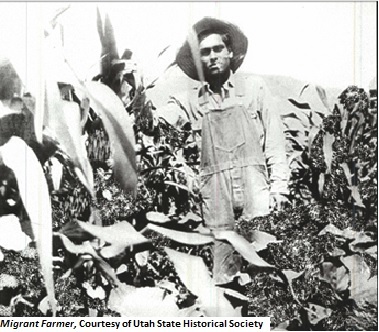Dublin Core
Title
Description
Migrant workers from Mexico have long contributed to Utah’s agricultural success. Their labor has been essential to the rural economy of the state.
Utah has long relied on migrant labor for its agricultural success. In 1918, for example, sixty families from Juarez, Mexico, came to work in the sugar beet fields of Garland, Utah, a small town in Box Elder County built around the Utah-Idaho Sugar Company factory. Local farmers had increased their sugar beet acreage, but faced with labor shortages associated with World War I, the company brought workers from Mexico for the harvest.
These workers and their families established a community on the outskirts of Garland in small houses provided by the company for $2 per month. According to a Salt Lake Tribune report of 1920, the houses “look[ed] like cross sections of freight cars… sparsely furnished... and papered with the colored advertising pages of American weeklies.” The families retained many of their cultural practices, and celebrated Mexican holidays with feasting and music. The county furnished a teacher for the migrants’ children, and the sugar company paid the workers to build a schoolhouse, which they did by making adobe bricks from clay found near the Malad River flats. According to the Tribune report, the Mexican families received a friendly reception from the Garland townspeople, and unlike other parts of the state and country, they were welcome at local movies and restaurants and even – if the sad occasion arose – in the local cemetery.
But this pleasant picture of Garland belies the fact that life for migrant workers and their families was often arduous. Many faced discrimination and endured poor living conditions. When not needed in the fields, men supplemented the family income with work on the railroad and women hired out as domestic servants. Within the fields, the work of beet harvesting was a family affair. One man recalled working “from the time I was about seven... You were down on your knees...hour after hour...and the sun would be beating on you... But we were hungry...our parents would tell us, ‘We have to do it to feed the younger ones.’”
In 1920, Utah farmers produced $28,000,000 worth of sugar from beets, giving them third place nationally and making sugar production second only to mining in Utah. To meet the demands of Utah farmers, more and more Mexican migrant workers came to toil in the state’s fields, and their labor underpinned Utah’s agricultural success.
Creator
Source
Image: Migrant Farmer. Migrant farmers came to Utah to work in the sugar beet fields and on other farms. Since then, farm workers represent the invisible link in Utah agricultural economy. Courtesy of Edward H. Mayer, Utah State Historical Society.
_______________
See Miriam B. Murphy, “Mexican Families and the Sugar Industry in Garland,” History Blazer, November 1995, accessed http://historytogo.utah.gov/; Charles Peterson, “Agriculture in Utah,” Utah History Encyclopaedia, http://www.media.utah.edu/UHE/UHEindex.html; Frank A. Arnold, Salt Lake Tribune, June 13, 1920; Vicente V. Mayer, "After Escalante: The Spanish-speaking People of Utah," in The Peoples of Utah, ed. Helen Z. Papanikolas (Salt Lake City: Utah State Historical Society, 1976); and "Migrant Labor" clipping file, Utah State Historical Society Library.

